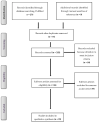Onychomycosis Caused by Fusarium Species
- PMID: 35448591
- PMCID: PMC9027400
- DOI: 10.3390/jof8040360
Onychomycosis Caused by Fusarium Species
Abstract
Onychomycosis is a nail fungal infection that produces nail discolouration, thickness, and separation from the nail bed. The species of the Fusarium genus that cause onychomycosis are emerging and the number of cases has increased throughout the years. Microscopic examination, as well as cultures, are required for the accurate diagnosis of onychomycosis. The goal of treatment is to eliminate the organism that causes the disease and restore the nail's normal appearance. Here, we provide an overview of the onychomycosis cases that have been reported in literature over the last 24 years, which have been caused by the Fusarium species. We performed a review on the onychomycosis cases caused by the Fusarium species from January 1997 to January 2021. Patients aged between 40 and 49 years made up 30.23% of the cases. The most common aetiologic species was Fusarium solani species complex (FSSC), which accounted for 44.11% of the cases, followed by F. fujikuroi species complex (FFSC), which accounted for 17.64%; 14.70% of the cases were due to F. dimerum species complex (FDSC) and 14.70% of the cases were due F. oxysporum species complex (FOSC). Europe accounted for 29.06% of the cases caused by FOSC, whereas Africa accounted for 46.67% of the cases due to FSSC. The clinical presentation of onychomycosis due to Fusarium spp. is commonly the distal-lateral pattern of onychomycosis. Identification of the infectious agent in onychomycosis cases due to Fusarium is crucial in deciding the proper treatment. Although antifungal susceptibility tests have only been performed in a few cases, susceptibility testing can help with patient management.
Keywords: Fusarium; clinical features; epidemiology; mycology; onychomycosis.
Conflict of interest statement
The authors declare no conflict of interest.
Figures
References
-
- Gupta A.K., Sibbald R.G., Andriessen A., Belley R., Boroditsky A., Botros M., Chelin R., Gulliver W., Keast D., Raman M. Toenail Onychomycosis-A Canadian Approach with a New Transungual Treatment: Development of a Clinical Pathway. J. Cutan. Med. Surg. 2015;19:440–449. doi: 10.1177/1203475415581310. - DOI - PubMed
Publication types
LinkOut - more resources
Full Text Sources
Miscellaneous


